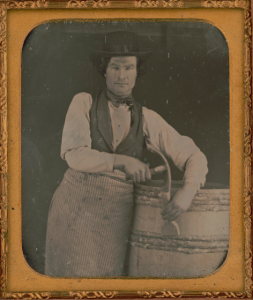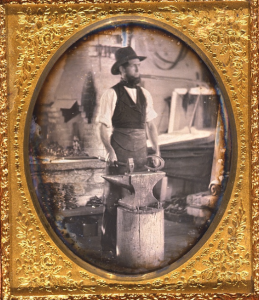Historical Trades: Saddlery, Logging, Coopering, Blacksmithing
If the characters in your novel are involved in the historical trades of saddlery, logging, coopering or blacksmithing, these book and website resources will help.
Saddlery and harness
Websites:
QUAIL’S SADDLERY COLLECTION/NATIONAL MUSEUM OF AUSTRALIA
The collection has 3000 objects from the Quail family of saddle makers in New South Wales, covering 1890 through about 1970. Photos of selected objects are available on the website, such as a mallet tool, wax and thread, and pictures of the Quail establishments.
EQUINE HERITAGE MUSEUM/GLOSSARY OF HARNESS PARTS
If you want to be able to name the correct harness part in a scene of your historical novel when the characters are working with a horse and buggy, this page of the EHM’s website will tell you what a crupper, doubletree, or a hame strap is. The diagrams of various harness parts are also useful. You may also want to explore the Museum’s other sections of its website, such as one on the medieval horse, and another on horses and wheeled vehicles.

Cowhand working with leather in saddle room. Quarter Circle ‘U’ Ranch, Montana, 1939. Credit: Library of Congress control number 2017777876
Books:
SADDLE OF QUEENS: THE STORY OF THE SIDE-SADDLE
By Lida Fleitmann Bloodgood. J.A. Allen, 1959.
This slim volume covers the history of women riding horses from ancient times to 1959, but concentrating on the side-saddle era. Illustrations from ancient and medieval manuscripts, and photos of early saddles show what riding was like in historical times. A bibliography will lead the researcher to further resources.
THE FAIR LADY ASIDE: HER SADDLES AND HABITS
By Mary L. Thomas. World Sidesaddle Federation, [1990?].
As with the above volume, drawings and photos of saddles depict ladies’ riding equipment, with emphasis on 19th century through today. A glossary and bibliography will aid researchers further.
THE ARTS IN THE MIDDLE AGES AND THE RENAISSANCE: CHAPTER TITLED “CARRIAGES AND SADDLERY”
By Paul Lacroix. Bracken Books, 1996.
This is a reprint of an 1870 book. The chapter on carriages and saddlery includes black and white drawings from manuscript illustrations. Spurs, stirrups, and litters are discussed, but the emphasis is on conveyances. Authors writing stories set in the medieval period in general may want to consult this book, as it has chapters on topics like ceramics, armor, clocks, playing cards, and glass painting in medieval times.
NEW BOOK OF SADDLERY AND TACK
Edited by Carolyn Henderson. Sterling, 2002.
Chapter one, “History and Development,” contains color and black and white photos of horse equipment through the centuries, with nice explanatory text. Assyrian bits, Roman spurs unearthed in London, and a 16th century royal Spanish saddle are some of the examples shown. Chapter two shows how a modern saddle is made. The emphasis is on English saddles and equipment, but chapters also cover Western, racing, and side-saddles. A later chapter discusses driving and farm harness equipment.
Coopering
Websites/YouTube videos:
BARREL MAKING AND COOPER INITIATING
A YouTube video of a 1949 British Pathe film showing how barrels are made by hand. It has an amusing section where an apprentice cooper is initiated into journeyman status by being dumped into a barrel, and doused with oak shavings, water and beer, and then rolled in the barrel around the shop.
TRADITIONAL COOPER: GEORGE SMITHWICK, HISTORY AND HOW TO MAKE A WOODEN BUCKET
A 52-minute YouTube video of George Smithwick of Sydney Living Museums, talks about wet and dry coopering, makes a wooden bucket, demonstrates tools, and talks about his family history in the business.
REVOLUTIONARY WAR JOURNAL: COOPERS HAD THE COLONISTS OVER A BARREL
I could not find an “about” page on this website, so it’s hard to judge its authenticity. The author is credited as Harry Schenawolf, a retired teacher and amateur historian, and this posting about coopers in U.S. history has enough interesting material to include in this list. “From the time of Jamestown, and for the next two hundred and fifty years or more, there were more coopers in the south than any other artisan profession.” It was an occupation much in demand in the Colonial era. The post includes a history of cooperage back to ancient times, with interesting illustrations. Use this site with caution, but reading it might spark some ideas for your next story.
Books:

Occupational portrait of a cooper, three-quarter length, with barrel and tools, 1840-1860. Credit: Library of Congress control number 2004664286
WOOD, WHISKEY AND WINE: A HISTORY OF BARRELS
By Henry H. Work. Reaktion Books, 2014.
The author became interested in the history of the cooperage trade when working at a Napa Valley firm selling and repairing wine barrels in the 1970s. Chapters in the book cover the barrel industry among the Celts, Romans, in the Middle Ages, and beyond. Usage of barrels in the whaling trade, the rise of guilds, and the sourcing of oak are covered. The last few chapters discuss modern uses of barrels in the whiskey and wine trades. An extensive reference list and bibliography provide sources for further research.
THE COOPER AND HIS TRADE
By Kenneth Kilby. John Baker, 1971.
“There are no amateur barrel-makers. Coopering is a skill acquired through years of sweating, muscle-aching, back-breaking labour ‘at the block’ as coopers say.” The author followed his father into the coopering trade in 1941, and the first chapter describes his experiences as an apprentice. The book’s emphasis is on the trade in the U.K., but also covers Egypt, Assyria, Rome and ancient Britain. It contains useful line-drawings of the parts of a barrel and modern tools used for making same. The historical section has drawings and photographs of ancient tools, a Bronze Age bucket, barrels depicted in medieval manuscripts, etc. Kilby’s bibliography will be useful for further research.
Logging (North America)
Websites:
KINSEY BROTHERS PHOTOGRAPHS OF THE LUMBER INDUSTRY AND THE PACIFIC NORTHWEST, CA.1890-1945

A Giant Fir tree, with lumberjacks, one lying in cut in tree, and other persons in front of tree, 1902. Credit: Library of Congress control number
2006680008
These are photos from brothers Darius and Clark Kinsey, who photographed the logging trade in the Pacific Northwest, available from the University of Washington Library’s website. You can click on subheadings like “lumber camps,” “Asian workers,” and “Mess halls and cooks” to get a nice selection of photos which could provide material for great word pictures in your novel set in the lumber industry in the early 20th century. Click on a photo’s thumbnail image to bring up a descriptive paragraph.
POTLATCH HISTORICAL SOCIETY COLLECTION
If you click on “logging” in the “top subjects” box, you will see over 1,900 photos of the logging industry around Potlatch, Idaho between 1890 and 1998. They depict equipment, mess hall workers, tools, boats and railcars which hauled logs, and related print documents. Click on “view full record” underneath the image to see more about each document.
SQUAMISH HISTORY ARCHIVES/LOGGING
This site is maintained by the Squamish, British Columbia Library, and offers 186 documents of logging in the Squamish area. I couldn’t find a collection description for these, but they seem to be a combination of modern and historical photos. I saw pictures of bunk houses in 1926, a river drive in 1950, and articles from the local newspaper on the industry.
If you use the above link and enter “logging” in the search box, you will retrieve over 680 “log”-related photos and documents in the state of Georgia. The first few pages are actually about the logging industry, but as you page forward you will see that you also retrieved documents related to log cabins and mariners’ logs.
Blacksmithing
Websites:
BLACKSMITHING: A MANUAL FOR USE IN SCHOOL AND SHOP
This e-book, offered by Cornell University’s website, is by R. W. Selvidge and J. M. Allton, and published by Manual Arts Press in 1925. It was designed as a textbook for shop classes and for blacksmiths wanting to further their knowledge. Chapters include bending pipe, renewing wagon tires, shoeing a horse, and measuring and cutting stock. An “informational” section covers fuel for the forge’s fire, drawings of various tools, and the different types of iron and steel. Even if your novel is set before 1925, some of the tools and techniques would be the same.
NEW YORK PUBLIC LIBRARY’S DIGITAL COLLECTIONS

Portrait of a blacksmith in his workshop, ca. 1855. Credit: Library of Congress control number 2008680496
If you search on “blacksmithing” in the search box, you’ll pull up over 168 images of blacksmiths at work, including some from 1800s India. One of the more amusing ones is a blacksmith repairing a lady’s hoop skirt while she is still wearing it. A sad document is a note written by a slave owner in 1861 offering one of his slaves for hire to a blacksmith’s shop.
VOICE OF THE HAMMER: THE ART AND MYSTERY OF BLACKSMITHING
This is another e-book, by Timothy Cumrin, archivist/historian at Connor Prairie, a living history museum in Indiana, published in 1992. The book’s intent is to “offer a glimpse into the life of the rural, Midwestern blacksmith during the first half of the nineteenth century.” It reproduces an indenture contract from 1822, discusses apprenticeships, and talks about a 19th century craftsman’s life. Photographs are included, as is a bibliography.
Another digitized book on the topic, by J.M. Drew, a blacksmithing instructor at the University of Minnesota. The book was published in 1918 by Webb Publishing, and is available on Google Books. It covers furnishing a shop, tools and their costs, types of metal, simpler projects for beginners, and of course, how to shoe a horse.
AND:
There are a lot of videos on blacksmithing techniques on YouTube, although you may have to wade through a bunch associated with the online game Minecraft, especially if you search on “medieval blacksmith.” Just remember to apply the CRAAP test to evaluate whether the videos will be useful for your novel’s research:
How CURRENT is the video? (Older videos might still be OK for a historical topic.)
Is it RELEVANT to your topic?
What’s the video’s AUTHORITY—who’s the author? Is he or she qualified enough to be an authority on the topic?
How ACCURATE is it? Does the video provide source material for the information?
What’s the video’s PURPOSE? Is the author disseminating information, or trying to sell you something?
About the contributor: B.J. Sedlock is Lead Librarian and Coordinator of Metadata and Archives at Defiance College in Defiance, Ohio. She writes book reviews and articles for The Historical Novels Review, and has contributed to The Sondheim Review.






